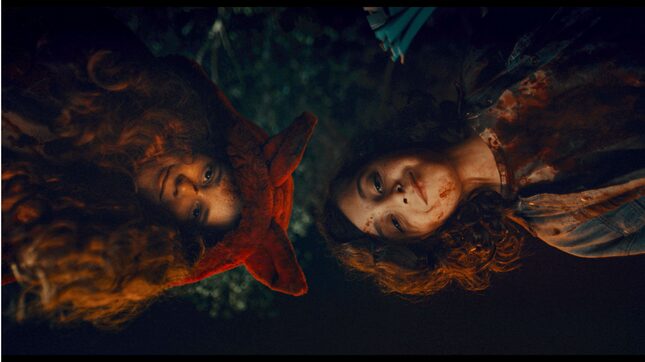Horror Film There’s Something Wrong With the Children Grapples With the Pressure to Have Kids
Director Roxanne Benjamin spoke with Jezebel about the decision to make this particular movie amid a torrent of reproductive pressure in her own life.
EntertainmentMovies

Horror film director Roxanne Benjamin is sick of constantly getting sent scripts about people who are in the phase of their lives where they are either pregnant or have recently had a baby, and the baby is in danger. “You know they’re sending it to you because they’re like ‘Oh it’s a female filmmaker—we have just the one for her!’” she told Jezebel in a phone interview. “I just want to flip a table.”
“As someone who does not want or plan to have kids and has never been in that state, it gets very frustrating,” she continued.
So when Benjamin was sent the script for There’s Something Wrong with the Children, a supernatural thriller in which the kids themselves are the problem— not the victims in need of protection—her interest was piqued.
There’s Something Wrong with the Children focuses on two married couples — one parents, the others not—on a weekend getaway in the woods. Ellie (Amanda Crew) and Thomas (Carlos Santos) are having marital problems, so Margaret (Alisha Wainwright) and Ben (Zach Gilford) offer to watch their two young children (played by Briella Guiza and David Mattle) for a night. But in the morning, the kids go missing—and once the adults find them again, Ben suspects something creepy has happened to them.
I am not a horror film aficionado by any means — I am actually a total scaredy cat. In fact, an hour after watching this film, my toddler playfully surprised me while I was brushing my teeth at night, and I screamed so loudly my husband rushed in to see who was killing me. (It was not my toddler, but that’s only because I’m lucky that Benjamin does not direct my life.) However, the relationship dynamics in the film between the couples and Ellie and Margaret were so interesting to me, I could have watched an entire non-horror drama on their interactions. As it turns out, many of my favorite parts of the movie were heavily influenced by Benjamin, whose perspective shifted important nuances in the film’s characters.
In the original version of the screenplay, written by T.J. Cimfel and Dave White, Margaret desperately wants to have kids and tries to talk her husband into having them. The whole weekend is actually planned so that Ben can spend more time around children so that she can convince him.
“It’s what she wants more than anything,” said Benjamin, recalling the original script. “I was like, I don’t love that for her as a character.”
Benjamin changed it so that Margaret is more ambivalent about having children, happy to travel and live her life kid-free. If anything, Ben is the one who seems to want kids more, and she questions her husband on whether she might be holding him back from it.
This shift enhances the film, not only because it gets away from the stereotype of a woman desperate to fulfill her natural desire to procreate, but because it creates a realistic tension between Margaret and Ellie. The result is conversations between the two close friends, where the fact that one of them has children and the other one doesn’t is a catalyst for tension.
Benjamin said she really wanted to focus on Ellie and Margaret’s relationship changing because one of them had kids and one doesn’t, and how there can be resulting envy and resentment on both sides. The director said that in her own life, she feels like people are always asking her when she’s going to take the perceived “next step” in her life.
“It feels like ‘Invasion of the Bodysnatchers,’ and people are like ‘I’m married now, when are you going to be married too?’ or ‘When are you going to have kids?’” said Benjamin, adding that people often want to be having the same shared experience with their friends. “It feels like someone’s trying to get you to join the cult and you’re like, ‘Man, I don’t know if I’m in for this cult.’”
Writers Cimfel and White had always written Ben as the gaslit narrator, which Benjamin appreciated because it is a characteristic that’s such a trope in horror for female characters. “Now we are questioning his reliability, and it’s like, ‘How’s it feel, bro?’” laughed Benjamin.
The point of view at the start of the film is on Ben, then shifts to Margaret. The original ending portrayed Margaret as a “shrieky, hysterical woman,” but Benjamin wanted to make it more about Margaret’s survival story to escape this family she’s being forced into and doesn’t want.
“I sent this ending in and I was like, they’re never going to let me get away with it. And we kept going along in prep and nobody said anything and then we shot [my ending] the first day and I’m like, ‘Okay, Now it’s in!’”
Without giving away too much of the final scenes, Benjamin spoke with me about the symbolism behind her new ending and the message she wanted to send about the reproductive pressures that are repeatedly imposed on women. “This question won’t die; this pressure won’t die,” said Benjamin. “It’s something that we’re just forced to deal with. Being a woman, this is a pressure that you don’t get out of.”
There’s Something Wrong with the Children premieres on VOD and digital on Jan. 17 and will start streaming on MGM+ on March 17.